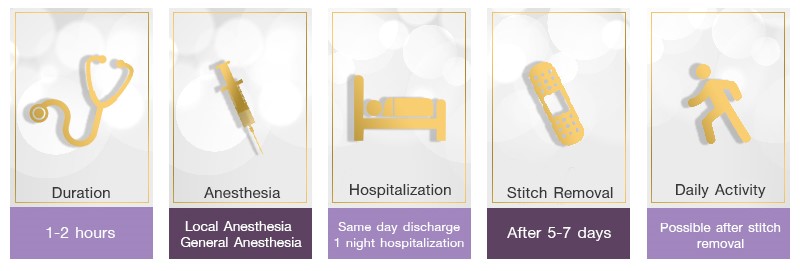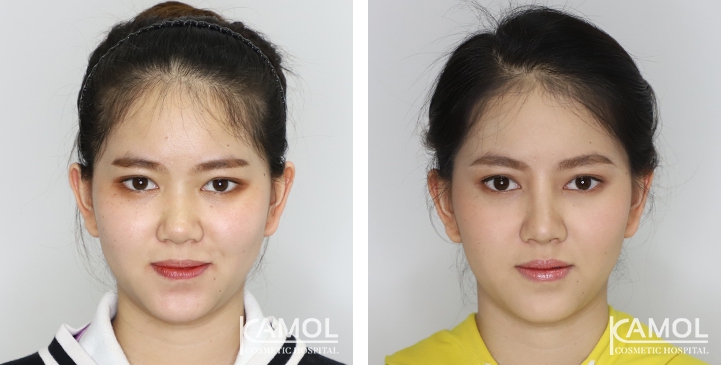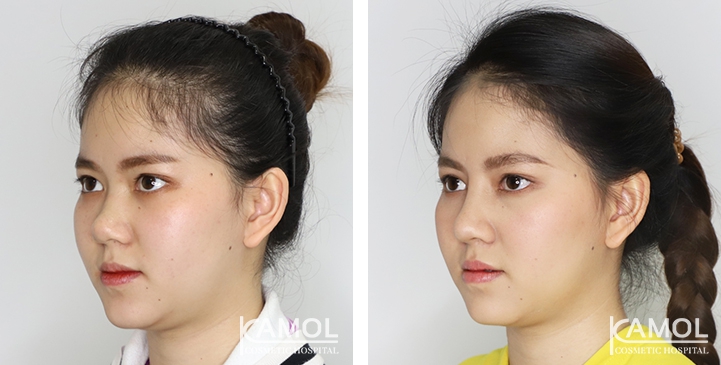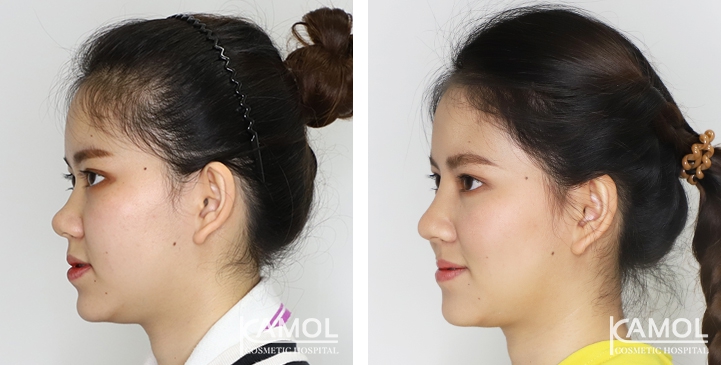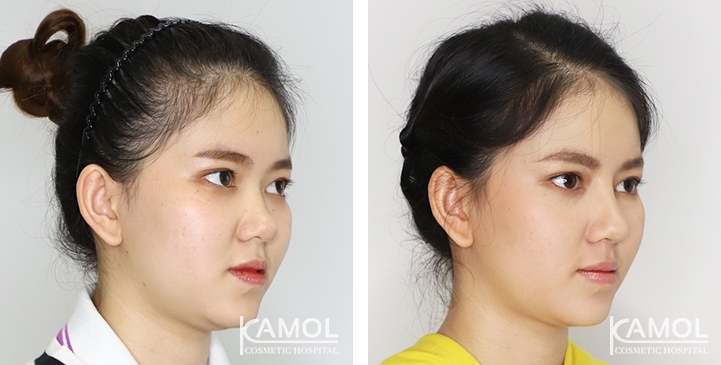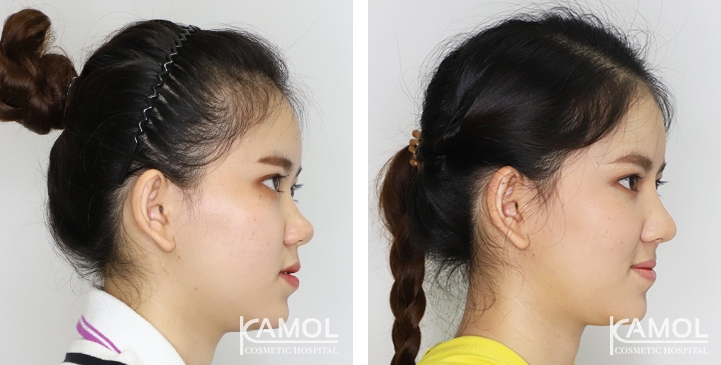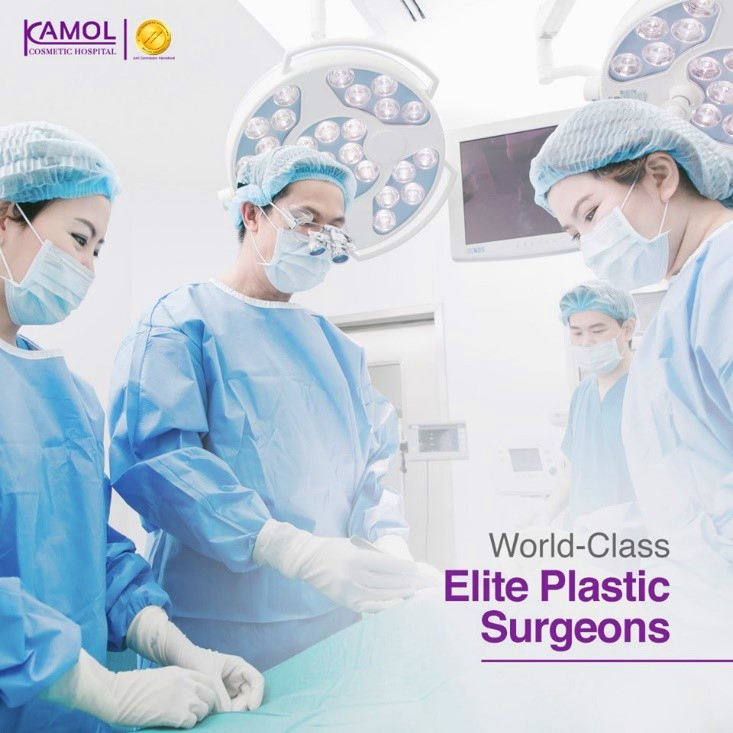Nose Implant Surgery / Augmentation Rhinoplasty in Bangkok, Thailand
Rhinoplasty is one of the most popular plastic surgeries performed worldwide. However, it is a complex procedure and requires an experienced and skilled surgeon to minimize the risk of complications. Choosing a surgeon with a proven track record and a reputation in the industry is crucial. Our Hospital is renowned for performing thousands of successful rhinoplasties each year, and our surgeons are experts in working with all types of noses and ethnicities.
Rhinoplasty, a nose implant or augmentation, is a popular cosmetic surgery that aims to enhance the nose's appearance. The nose is considered a key feature in determining facial attractiveness, and a nose that is well-proportioned to the face can improve confidence and self-esteem. In particular, rhinoplasty is commonly performed on Asian noses, which tend to be wide and flat with large nostrils.
The procedure can involve using silicone implants to lift the ridge of the nose and make it more attractive, as well as alarplasty to adjust the size of the nostrils. It is essential to choose a skilled and experienced surgeon who can tailor the surgery to suit the individual's face, personality, gender, and age.
What conditions can be addressed with Rhinoplasty?
Rhinoplasty, also known as a nose job, is a surgical procedure that can address various concerns related to the nose. Some common conditions that can be treated with rhinoplasty include:
- Nasal asymmetry: correcting a crooked or uneven nose
- Nasal obstruction: improving breathing by addressing issues such as a deviated septum
- Nasal tip issues: reshaping the tip of the nose to make it more proportionate to the rest of the face
- Nasal hump: removing a bump or hump on the bridge of the nose
- Nostril size: reducing the size of the nostrils to create a more balanced look
- Rhinophyma: treating an enlarged nose caused by rosacea.
It's important to note that each individual's case is unique, and some conditions may require a different approach and technique. Therefore, it's recommended to consult with a board-certified plastic surgeon who can evaluate your case and recommend the best course of treatment.
Consultations with the Surgeon
I think it's essential to have initial conversations with the surgeon to express your desired outcomes clearly and receive professional guidance in making informed decisions. The surgeon will suggest appropriate procedures to achieve the desired nose shape and appearance during the consultation.
I. Nose Implant / Augmentation Rhinoplasty:
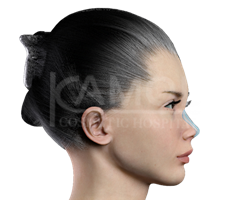
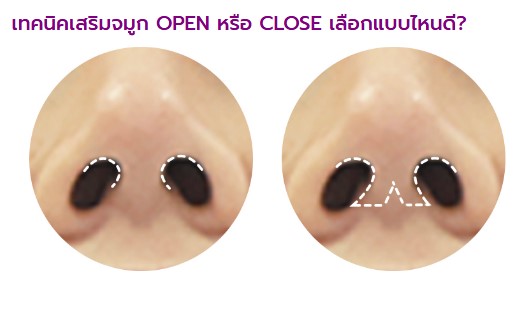
Picture 1: The differences between open and closed techniques in Rhinoplasty
What are the differences between open and closed techniques in Rhinoplasty?
Open and closed rhinoplasty are surgical techniques used to perform a nose job.
- Open rhinoplasty involves making an incision across the columella (the area between the nostrils) to access the internal structures of the nose. This allows for greater visibility of the underlying cartilage and bone and enables the surgeon to make more extensive adjustments to the nose.
- Closed rhinoplasty, conversely, uses incisions made inside the nose, leaving no visible scars. The closed technique corrects nasal cartilage, bone, and septum. It has the benefit of a slightly shorter recovery time compared to open rhinoplasty.
Both techniques have advantages and disadvantages; choosing which one to use depends on the specific case and the surgeon's preference. I'd appreciate it if you could discuss the options with a board-certified plastic surgeon.
Which procedure is better?
Closed rhinoplasty may have a slightly shorter recovery time and less swelling. Still, open rhinoplasty may be more suitable for complex cases that require more precision and visibility of the underlying structures.
It's important to note that the surgeon decides which technique to use based on the individual case and the desired outcome. The differences between the two methods must be more significant to impact the recovery process or scarring significantly.
Rhinoplasty is one of the most popular plastic surgeries performed worldwide. However, it is a complex procedure and requires an experienced and skilled surgeon to minimize the risk of complications. Choosing a surgeon with a proven track record and a reputation in the industry is crucial. Our Hospital is renowned for performing thousands of successful rhinoplasties each year, and our surgeons are experts in working with all types of noses and ethnicities.
Of all facial surgeries, rhinoplasty has the most significant impact on the face's overall appearance. It can significantly enhance the attractiveness of the nose and, in turn, positively impact self-confidence and self-esteem, leading to an overall improvement in quality of life.
Materials used in Nose Implant:
Some of the commonly used materials in rhinoplasty implants include:
- Soft silicone: Soft silicone is a popular choice for rhinoplasty implants as it is soft, pliable, and conforms to the natural contours of the nose. It is also biocompatible and non-reactive, which makes it safe to use in the body.
- e-PTFE (Expanded Polytetrafluoroethylene) sheet: e-PTFE is a lightweight, flexible, and strong synthetic material commonly used for nasal dorsum (bridge) augmentation in Asian rhinoplasty.
- Body tissue such as bone and cartilage: Sometimes, a patient's body tissue may be used for the implant. Bone and cartilage can be taken from other body areas, such as the rib or ear, and used to shape and enhance the nose. This is a more natural option as it is the patient's tissue, and the risk of rejection is lower.
- PMMA (Polymethyl methacrylate) Customized Implant: PMMA is a synthetic polymer commonly used in medical and dental applications. It is a strong and durable material that can be customized to suit the individual's needs. It is also a good option for patients who want a long-lasting result.
It's worth noting that the choice of implant material depends on the patient's case, the surgeon's preference and expertise, and the desired outcome. Consultation with a board-certified plastic surgeon is crucial to determine the best implant material for you.
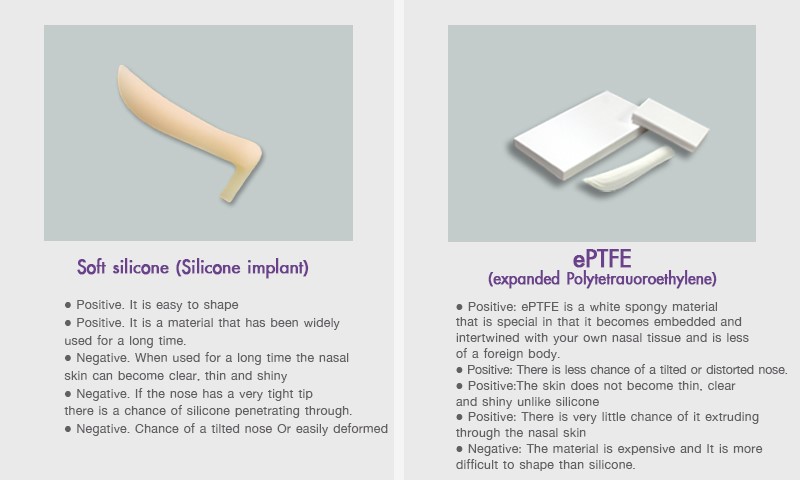
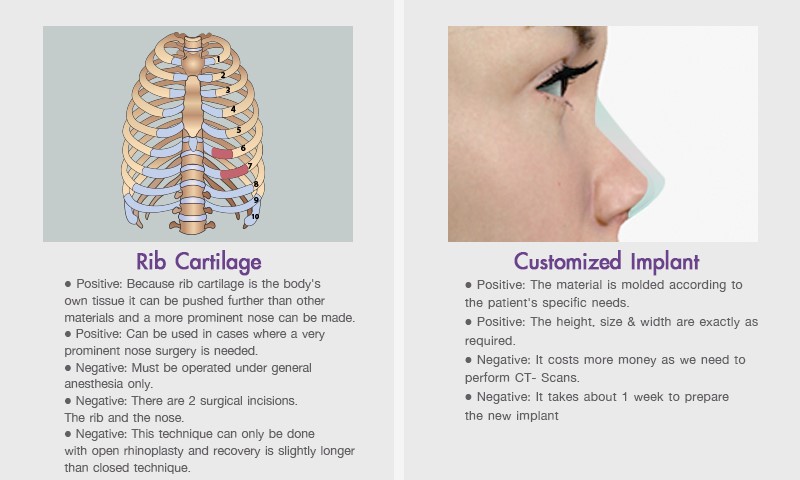
A good candidate for a Nose Implant:
You will be the right candidate if you are:
- Having a flat or drooping nose shape that you wish to improve.
- Being in good overall physical health.
- Having realistic expectations about the results of the surgery.
- Understand the risks and potential complications associated with the procedure and be willing to accept them.
- Being at an age where the nose has finished growing, usually around the age of 14 for girls and 16 for boys.
- Being emotionally stable and having a positive outlook.
Preparations for a Nose Implant:
Before undergoing augmentation rhinoplasty or a nose implant, it's important to schedule a consultation with the surgeon to discuss the procedure, your goals, and other important factors. The surgeon will also assess your medical history, conduct a physical examination, and ask for lab tests to determine your eligibility for the surgery.
It's crucial to follow the surgeon's instructions and guidelines for preparation, including:
- Avoid medications containing aspirin or ibuprofen for at least two weeks before and after the surgery, as they may increase bleeding.
- Avoiding herbal remedies and over-the-counter supplements.
- Ceasing smoking and drinking alcohol for at least two weeks before and after the surgery, as they can impede the healing process.
- Following any additional instructions provided by the surgeon regarding diet, exercise, and skincare leading up to the surgery.
It's important to be transparent with your surgeon about any medications you are taking, any underlying medical conditions, or any allergies you have so the surgeon can consider them when planning your surgery.
Picture 2: Process of Nose AugmentationRhinoplasty
Nose Implant Procedure:
The nose implant procedure is typically performed using local or general anesthesia, depending on the surgeon's recommendation.
The incision used in the procedure will depend on the type of surgery chosen and the surgeon's preference. The closed technique makes incisions inside the nose, resulting in hidden scars, while the open technique uses an incision across the columella (the area between the nostrils), and the scar will be difficult to notice.
Once the incision is made, the implant will be placed on the dorsal bone. The shape of the implant will be adjusted to ensure it is balanced and looks natural with the face. The incision is then closed, and the surgery is typically performed under local or general anesthesia, typically lasting 45 minutes to one hour.
I want to let you know that the procedure may vary depending on the individual case and the surgeon's preference and expertise.
Post-operative care for Nose Implant:
- Stitches inside the nose are absorbable sutures that will dissolve independently. Stitches on the outside have to be removed after 5-7 days after surgery.
- Keep your head above your chest when in bed to reduce bleeding and swelling. The surgeon will tape a splint to your nose for protection and support for about one week.
- Avoid strenuous activities such as aerobics and jogging.
- Take baths instead of showers while you have bandages on your nose.
- Do not blow your nose.
- Avoid extreme facial expressions, such as smiling or laughing.
- Brush your teeth gently to limit movement of your upper lip.
- Don't rest eyeglasses or sunglasses on your nose for at least four weeks after the surgery to prevent pressure on your nose
- Swelling or bruising of your eyelids can occur for two to three weeks after surgery.
- Limiting your dietary sodium (salt) intake will help the swelling go away faster.
- Do not put anything such as ice or cold packs on your nose after surgery
- Follow all post-operative instructions and attend all post-operative appointments.
Following your surgeon's instructions and guidelines for post-operative care is important to ensure a successful outcome.
Risks and Complications associated with Nose Implants:
- Scarring: Scarring is a potential risk of any surgical procedure, but the risk of visible scarring is usually minimal with a nose implant procedure.
- Bleeding: Some bleeding is normal after surgery, but excessive bleeding can lead to a hematoma (blood clot) and may require further surgery.
- Infection: An infection can occur at the incision site or around the implant. Antibiotics may be prescribed to prevent or treat a disease.
- Swelling, bruising, pain: These are common after a nose implant procedure and usually subside within a few weeks.
- Healing problems: Some patients may experience delayed healing or other issues with the healing process, which may require additional treatment.
- Extrusion of the implant: In rare cases, the implant may shift or become displaced, requiring further surgery to correct.
- Asymmetry: The nose may appear asymmetrical after the procedure, requiring additional surgery.
- Unsatisfactory results: Some patients may be unhappy with the final results of the surgery, which may require additional surgery to correct.
- Allergic reaction from the implant: In rare cases, the patient may develop an allergic reaction to the implant material, requiring the implant to be removed.
It's important to note that the risks and complications may vary depending on the individual case and the surgeon's preference and expertise.
Recovery Timeline for Nose Implants and Rhinoplasty:
The recovery process following a nose implant or rhinoplasty procedure varies for each individual. However, a general timeline can be as follows:
- In the first week, patients may experience swelling, bruising, and discomfort, and they must wear a cast or splint to protect the nose.
- In the first two weeks, the cast is usually removed, and any non-dissolvable stitches used will be removed. Patients may still experience some swelling and bruising, but it should start to subside.
- In the first month, most swelling and bruising should have dissipated, and patients can start seeing the surgery's initial results.
- Two to six months: the final results of the surgery will become apparent as the swelling dissipates.
You should take at least one to two weeks off work for recovery and avoid strenuous activities such as sports and heavy lifting for at least four to six weeks after surgery.
Getting to Know for Nose Implant / Augmentation Rhinoplasty
Rhinoplasty with rib cartilage
Rib cartilage is a strong, flexible and durable material that can be easily shaped...
Different rhinoplasty goals of different ethnicities
The goals of rhinoplasty can vary among different ethnicities, as individuals from...
What is ePTFE and Why we use ePTFE for Nose Implant
The use of e-PTFE, or Gore-Tex®, in medical procedures such as rhinoplasty...
Before & After Nose Implant / Augmentation Rhinoplasty
Video: Nose Implant / Augmentation Rhinoplasty
Why do people choose Kamol Cosmetic Hospital for Nose Implant Surgery?
Nose implant Surgery, also known as rhinoplasty or a "nose job," is a cosmetic procedure that is used to reshape the nose to improve its appearance or to correct structural issues that may be causing breathing problems. There are several reasons why someone may choose to have a nose implant, including:
- Improving the appearance of the nose: Many people are unhappy with the shape or size of their noses, and nose implant surgery can reshape the nose to make it more symmetrical or to reduce its size.
- Correcting structural issues: A nose implant surgery can also be used to correct structural issues that may be causing breathing problems, such as a deviated septum or a hump on the bridge of the nose.
- Improving self-esteem: A nose implant surgery can help improve self-esteem by giving someone a nose that they are happy with and feel confident about.
- Improve overall facial balance: A nose implant can help improve the face's balance and symmetry.
It is important to have an expert perform nose implants because the procedure involves changing the delicate and complex structure of the nose. An expert, such as a plastic surgeon specializing in nasal surgery, will have the necessary training, experience, and skills to ensure the procedure is performed safely and effectively.
An expert in nose implant surgery will have a detailed understanding of the anatomy of the nose, the different techniques that can be used to reshape the nose, and the potential risks and complications associated with the procedure. They will also have experience working with other types of patients and will be able to create a customized treatment plan that considers the patient's unique goals and medical history.
In addition, experts will know how to use the right type of implant to suit the patient's unique needs and will be able to make adjustments and corrections, if necessary, to achieve the best possible results.
Overall, consulting with a qualified and experienced expert such as Dr. Kamol for a nose implant surgery is crucial for achieving the desired outcome and minimizing potential risks or complications.
At Kamol Cosmetic Hospital, we:
- A team of experienced and qualified surgeons who specialize in nasal surgery
- A good reputation and positive patient reviews
- A high success rate for nose implant surgery procedures
- A range of options for the type of implant
- Adequate facilities and equipment to perform the procedure safely and comfortably
- Are familiar with Asian and European noses
- A comprehensive after-care program
Why Thailand is a plastic surgery destination?
Thailand is a top destination for plastic and cosmetic surgery. The high quality and specialist skills of the surgeons, the first-class hospital treatments, and the affordable cost all add up to a satisfying all-around package. There is also the temptation to recover post-procedure in luxury hotels or recovery service apartments.


